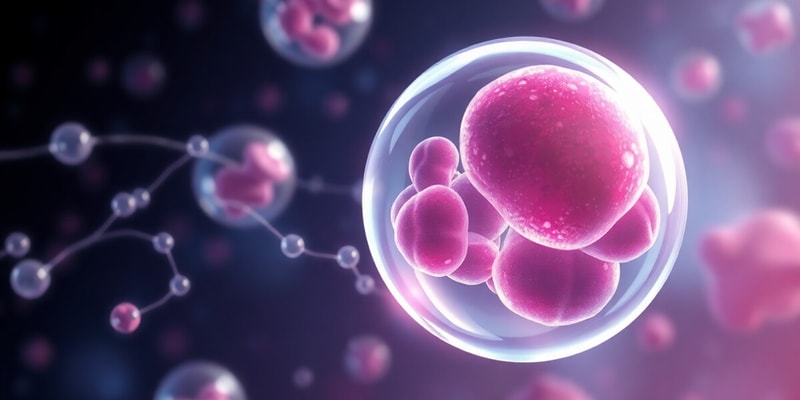Podcast Beta
Questions and Answers
What is the primary role of lipoproteins in the body?
Which component is most hydrophobic in the structure of lipoproteins?
What is the function of lipoprotein lipase in lipid metabolism?
How are nascent chylomicrons transformed into mature chylomicrons?
Signup and view all the answers
What happens to the glycerol produced by the action of lipoprotein lipase?
Signup and view all the answers
Which apolipoprotein activates lipoprotein lipase?
Signup and view all the answers
What characterizes chylomicron remnants after lipolysis?
Signup and view all the answers
Which method is NOT used for the separation of plasma lipoproteins?
Signup and view all the answers
What protein is specifically associated with the formation of nascent VLDL in liver cells?
Signup and view all the answers
What transformation occurs when nascent VLDLs interact with HDL in the bloodstream?
Signup and view all the answers
What enzymatic action leads to the degradation of TAG in VLDL?
Signup and view all the answers
What happens to IDL after undergoing hydrolysis of TAG and the removal of apo E?
Signup and view all the answers
How do LDLs provide cholesterol to extrahepatic tissues?
Signup and view all the answers
What is a key outcome of high levels of LDL-cholesterol?
Signup and view all the answers
What initiates the conversion of discoidal HDL into spherical HDL?
Signup and view all the answers
Which apoproteins are reservoirs found in HDL?
Signup and view all the answers
What is the primary function of HDL in the body?
Signup and view all the answers
Which lipoprotein is primarily responsible for transporting dietary TAG?
Signup and view all the answers
What characterizes familial hypercholesterolemia?
Signup and view all the answers
Which type of dyslipoproteinemia is characterized by slow clearance of chylomicrons and VLDL?
Signup and view all the answers
Which lipoprotein serves as a precursor of LDL?
Signup and view all the answers
What is a common association with hypertriacylglycerolemia?
Signup and view all the answers
What results from excess production of VLDL?
Signup and view all the answers
What is the main function of LDL in the body?
Signup and view all the answers
Study Notes
Overview of Lipoproteins
- Lipoproteins are complexes of lipids and proteins that facilitate lipid transport in body fluids.
- Lipids are housed in a core of triacylglycerols and cholesteryl esters, surrounded by phospholipids, cholesterol, and apolipoproteins.
Types of Apolipoproteins
- Integral apolipoproteins (e.g., apo B) cannot be removed from lipoproteins.
- Peripheral apolipoproteins (e.g., apo C and E) can be transferred among lipoproteins.
Methods of Separation of Plasma Lipoproteins
- Ultracentrifugation: Separates lipoproteins into five fractions based on density.
- Electrophoresis: Separates lipoproteins into five fractions relying on molecular weight and charge.
Metabolism of Chylomicrons
- Chylomicrons transport dietary lipids from the intestine to the liver and other tissues.
- Synthesis occurs in the intestine and includes components like triacylglycerols, apo B-48, apo A, apo C, and apo E.
- Formation involves:
- Lipid synthesis on smooth endoplasmic reticulum (SER).
- Apolipoprotein synthesis by rough endoplasmic reticulum (RER).
- Assembly and packaging in the Golgi apparatus followed by exocytosis.
- Conversion to mature chylomicrons happens by gaining apo C and apo E from HDL.
- Degradation occurs via lipoprotein lipase, breaking down approximately 90% of triacylglycerols into glycerol and free fatty acids.
- Chylomicron remnants are formed after lipoprotein lipase action and are endocytosed by liver cells through apo E receptors.
Metabolism of VLDL, IDL, and LDL
- Nascent VLDL is formed in the liver containing apo B-100 and transports TAG from the liver to peripheral tissues.
- VLDL matures by acquiring apo C and apo E from HDL.
- Lipoprotein lipase degrades up to 50% of TAG in VLDL.
- VLDL remnants are termed IDL, formed after lipoprotein lipase action.
- IDL converts to LDL through further TAG hydrolysis and apo E removal.
- LDL primarily transports cholesterol from the liver to extrahepatic tissues, binds to apo B-100 receptors, and has a role in atherosclerosis risk.
Metabolism of HDL
- HDL is synthesized in the liver and small intestine as discoidal HDL, which consists of a phospholipid bilayer, free cholesterol, and various apolipoproteins.
- HDL collects free cholesterol from tissues and transforms via esterification by LCAT, generating spherical HDL.
- HDL acts as a reservoir for apoproteins and facilitates reverse cholesterol transport to the liver for elimination.
- HDL also exchanges cholesteryl esters and triacylglycerol with chylomicron remnants and LDL.
Types and Functions of Lipoproteins
- Chylomicrons (CM): Transport dietary TAG from the intestine to peripheral tissues.
- VLDL: Transports endogenous TAG from the liver to peripheral tissues.
- IDL: Acts as a precursor to LDL.
- LDL: Distributes cholesterol from liver to peripheral tissues.
- HDL: Facilitates the transport of cholesterol from peripheral tissues back to the liver for disposal.
Primary Disorders of Plasma Lipoproteins (Dyslipoproteinemias)
- Familial Hypercholesterolemia: Defect in apo B-100 receptors causing elevated LDL and increased risk of atherosclerosis.
- Hypertriacylglycerolemia: Overproduction of VLDL linked to glucose intolerance, often seen in type II diabetes and obesity.
- Familial Lipoprotein Lipase Deficiency: Results in slow clearance of chylomicrons and VLDL, low levels of LDL and HDL, with no increased coronary disease risk.
Studying That Suits You
Use AI to generate personalized quizzes and flashcards to suit your learning preferences.
Related Documents
Description
This quiz covers the fundamental aspects of lipoproteins, which are essential for lipid transport in the body. It explains their structural components, including hydrophobic and amphipathic lipids, and their significance in the aqueous environment of body fluids. Test your knowledge on the various types and functions of plasma lipoproteins.




